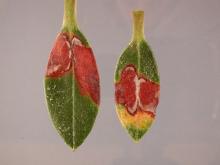See:
Rhododendron - Ramorum Leaf Blight and Shoot Dieback
Rhododendron - Phytophthora Blight and Dieback
Cause Dozens of fungi that have been found in association with leaf spots and/or leaf necrosis on rhododendron in the PNW. A few leaf spots did not have pathogens detected. The most frequent fungus encountered was Phytophthora ramorum due to the many surveys that have been conducted for this regulated pest. Many other fungi have also been found through these surveys. Other fungi frequently found by the OSU Plant Clinic include Cladosporium sp., Pestalotiopsis spp. (no formal reports), and Phyllosticta spp. Cladosporium herbarum is the only species reported and only for Washington. Phyllosticta spp., a fungus found on wild as well as cultivated rhododendron. P. rhodorae has been reported in Oregon while that and 6 additional species have been reported in Washington.
Many of these fungi enter the leaf through wounds due to abrasions, scalding or physical damage. They are also favored by wet weather and/or overcrowding that keeps leaves wet for extended periods of time. These fungi generally survive unfavorable conditions in plant debris.
Symptoms Cladosporium rhododendri - leaf spots on both side of leaf are irregular in shape and variable in size. They are often seen at leaf margins and extending towards the midrib. Spots are dark brown to somewhat greyish brown and on the upper leaf surface they are often covered by the whitish grey, detached leaf cuticle.
Pestalotiopsis - leaves have irregular, dark brown lesions with a clear blackish brown boundary and black fruiting bodies (acervuli) in a grayish center. A general rotting of the root and stem-base has also been reported in Europe.
Phyllosticta - Small, reddish brown spots occur anywhere on the leaf but more frequently at the leaf margins. Margins of individual spots are only slightly darker than the center. Spots may coalesce to form larger necrotic areas. Small black fruiting bodies (pycnidia) may develop in the spots.
Phytophthora ramorum - Leaf lesions penetrate through the plant tissue so that spots can be seen on both sides of the leaf. They can be triangular in shape and extend along the leaf petiole and midrib, or leaf spots can occur where water accumulates on the leaf margins. Leaf spots have diffuse margins and the appearance of watersoaking. If you suspect you have seen a P. ramorum-infected plant in Oregon, call the Invasive Species Hotline, 1-866-INVADER (1-866-468-2337).
Cultural control
- Remove and destroy affected leaves and fallen leaves.
- Prevent injury and give proper cultural care.
- Avoid overhead irrigation, or water such that plants are not wet for extended periods of time.
Chemical control
- Bonide Fung-onil Multi-purpose Fungicide at 2.25 teaspoons/gal water. Group M5 fungicide. H
- Mancozeb-based products. Group M3 fungicides. 24-hr reentry.
- Fore 80 WP at 1.5 lb/100 gal water plus a spreader-sticker.
- Protect DF at 1 to 2 lb/100 gal water plus 2 to 4 oz spreader-sticker.
- Monterey Liqui-Cop at 3 Tbsp/gal water. H
- Monsoon Turf at 4 to 10 fl oz/100 gal water. Group 3 fungicide. 12-hr reentry.
- Nu-Cop 50 DF at 1 lb/100 gal water. 48-hr reentry.
- Ortho Rose & Flower Disease Control at 2 fl oz/gal water. Group 3 fungicide. H
- Pageant at 8 to 12 oz/100 gal water. Do not use with organosilicone-based adjuvants. Group 7 + 11 fungicide. 12-hr reentry.
- Spectro 90 WDG at 1 to 2 lb/100 gal water. Group 1 + M5 fungicide. 12-hr reentry.
- Tourney EZ at 1 to 4 oz/100 gal water. Group 3 fungicide. 12-hr reentry.
Reference Linderman, R.G. and Benson, D.M. 2014. Compendium of Rhododendron and Azalea Diseases and Pests, 2nd ed. St. Paul, MN:APS Press.
Davis, B.H. 1946. Guignardia rhodorae, the perfect stage of Phyllosticta maxima on Rhododendron. Mycologia. 38:40-51.


